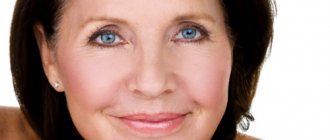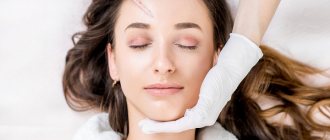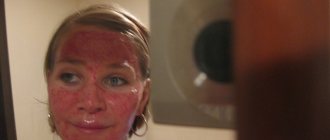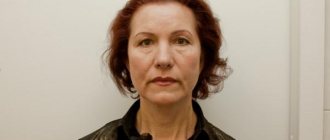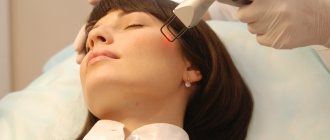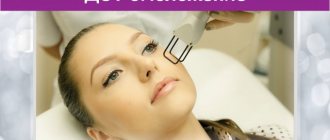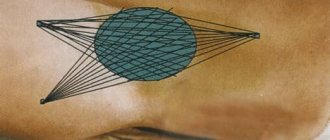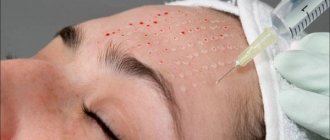Laser facial resurfacing - returning youth and attractiveness
Ensuring beauty by laser removal of scars on the face is important not only for women, but also for men. Scarring changes in appearance after acne and injuries become a psychological problem at a young age. To eliminate pigmentation and wrinkles, ladies agree to endure a painful period of rehabilitation. To get results from laser facial resurfacing , three to ten procedures are prescribed.
Characteristics of laser facial resurfacing
The mechanism of the laser beam’s effect on the skin is to remove by burning the surface layer (epidermis), which plays a major role in the formation of scars and wrinkles. At the same time, the growth of a new young layer with blood vessels and collagen fibers is stimulated, providing nutrition and elasticity. Protection is activated by local immune cells.
During consultation, the doctor determines a possible option for using laser resurfacing : a certain area of the face is treated. The fractional grinding method is a gentle method of influence that allows you to activate renewal by creating a dot grid.
In the damaged area, areas subjected to intense thermal influence and untouched skin alternate.
What it is?
Laser facial resurfacing is one of the most popular procedures in hardware cosmetology, designed to stimulate the regenerative and reparative function of the dermis. As a result of laser exposure, the superficial and deep layers of the dermis are completely destroyed: the inactive collagen layer is destroyed, the volume of local deposits of melanin, which is responsible for skin pigmentation, is reduced, and the stratum corneum of the epidermis is exfoliated.
Lasers in cosmetology
In place of the destroyed components of the dermis, a new layer of skin is formed without pathological and structural changes. As a result, the face becomes fresher and more toned, while the lifting effect after laser rejuvenation is prolonged and lasts for 2-3 months after the procedure.
The operating principle of laser facial resurfacing is based on the effect of thermolysis - a physical reaction of the decomposition of chemical components under the influence of high temperature without the use of various accelerators and stimulants (catalysts). The laser beam penetrates the deep layers of the skin and heats it to 250-300C, as a result of which the old dermal layers are evaporated, in place of which new healthy cells begin to intensively form. This process is called regeneration and is the restoration of the normal cellular structure of the dermis and hypodermis while maintaining the full functional activity of epidermal cells.
Application of laser in cosmetology
Important! Laser facial resurfacing allows you to “rejuvenate” your skin by 4-5 years, but it is important to understand that the procedure only combats existing problems and does not prevent new defects. Aging of the body is a natural process that cannot be stopped, but with the help of laser thermolysis it is possible to correct its manifestations in the form of age-related and stress changes (gravitational ptosis, keratosis, wrinkles, etc.).
Preparation for laser scar removal procedure
Efficiency depends on compliance with the rules of preparation for the procedure when removing scar changes.
- If you have dark skin, you will need preliminary bleaching; if your complexion is normal, then cosmetologists advise you to stop sunbathing a month before the procedure, and when going outside, use protective creams with a high index 3 weeks beforehand.
- You must tell your doctor if you are taking any medications on a regular basis. Some have a photosensitizing effect and should therefore be discontinued first.
- If the scars are deep enough, then you may have to soften the surface layer with peeling before laser resurfacing.
Preparation
Before CO2 laser resurfacing, it is necessary to carry out preparatory measures.
As a rule, three days before the expected date of the manipulation, the cosmetologist prescribes antibiotic therapy. This will reduce the risk of skin infection during the procedure. Your doctor may also recommend taking antiherpetic medications.
For 14 days you will need to stop visiting the solarium and tanning in direct sunlight.
If the patient has skin phototype 3-5, the preparatory stage will include a whitening procedure using special means. These actions must begin 6-7 weeks before the main manipulation.
Advantages and disadvantages of laser resurfacing
The use of laser resurfacing is not the only method of treating scars.
The advantages of the technique include:
- Possibility of use at young and old ages;
- long-term effect (3–4 years);
- short sessions;
- absence of thinning of the skin at the site of exposure, damage to healthy tissue;
- facial muscle lifting effect;
- use in any part of the body;
- guaranteed safety.
Deficiencies are revealed as the areas exposed to the beam heal:
- pain, need for pain relief during deep facial resurfacing;
- inability to use at home;
- the need for a significant recovery period;
- presence of contraindications;
- probability of complications in 10% of patients;
- low availability due to relatively high prices.
Advantages and disadvantages
The advantages of the CO2 laser include safety, high efficiency, low cost per session, and rejuvenating effect.
Disadvantages include a long rehabilitation period, the need to prepare and perform more than one procedure to achieve the desired result, and the presence of contraindications.
CO2 laser resurfacing is a modern cosmetic procedure, thanks to which you can preserve youth and beauty for a long time. However, you need to be aware of the limitations and possible consequences. To prevent them, you should contact only trusted clinics.
What does laser resurfacing of facial scars provide?
The devices allow you to change the depth of penetration and the strength of the thermal effect. Depending on the age and density of the scars for treatment:
- softening of scars is prescribed, creating the possibility of transformation into healthy elastic tissue;
- Laser resurfacing, called microdermabrasion, is performed with an erbium laser when softening is not enough and complete removal of scar tissue is required.
Grinding the skin of the face may require several minutes in one case, and more than an hour in another, with subsequent repetitions. The method allows you to choose the right technique to get rid of any scars.
Why does our skin age?
- With age, cells divide less frequently and less active substances are released that maintain skin tone.
- Weakened tissues resist gravity less well and float downwards – gravitational ptosis develops.
- Creases form in the dermis - wrinkles appear
- Neglecting photoprotective cosmetics causes uneven pigmentation
- Poor tissue nutrition leads to the development of vascular networks
Using a laser, all age-related signs on the face and body are eliminated or significantly reduced. If necessary, scars, stretch marks, and tattoos are removed.
Laser resurfacing for young people after acne
Acne in young people is caused by inflammation and blockage of the sebaceous glands. After it, many small scars remain, turning the facial skin lumpy and swollen. For teenagers, cosmetologists recommend diet, regular cleaning, and peeling. If there is no effect, then you have to resort to scar removal using facial skin resurfacing . Depending on the density and extent of tissue changes and an assessment of a person’s ability to recover, mechanical or laser resurfacing is selected . The beam penetrates to a sufficient depth and not only smoothes the surface of the skin, but also relieves the hyperactivity of the sebaceous glands.
In post-acne treatment, different device settings are used:
- ultraviolet spectrum - used for minor changes to stimulate and restore elasticity;
- infrared - removes the epidermis layer, renews the underlying tissues.
If the cause of acne is hormonal imbalance, then facial resurfacing will not help. Therefore, cosmetologists recommend mandatory consultation with an endocrinologist.
Indications
This cosmetic procedure is prescribed if the following problems exist:
- the appearance of stretch marks ;
- scars and tissue scarring;
- pronounced wrinkles ;
- striae;
- acne rashes and traces after them;
- formation of vascular network;
- pigmentation ;
- condylomas and warts;
- fungal infections;
- consequences of tattoos .
In addition, indications include rhinophyma, hyperplasia of the sebaceous glands, mild lentigo, seborrheic keratosis.
How is laser resurfacing done?
Laser skin resurfacing is carried out in the face, neck, décolleté, and any part of the body. Various devices and attachments allow you to act on certain areas. Since the thermal effect extends to a sufficient depth, cosmetologists eliminate the double chin and excess fat folds.
Features of face resurfacing
The skin on the face is highly sensitive. The latest generation devices cause moderate discomfort and a burning sensation during operation, but then cool the area.
- The doctor sets the necessary parameters for the beam length.
- Before the procedure, moisturizer is applied to the patient's face for 20 minutes.
- If an area with hair is to be treated (temple, beard, chin), then the hair is first removed by shaving or paraffin.
- Irradiation of individual points and zones is carried out several times per session.
- After finishing, a cream is applied to relieve irritation.
Moderate redness and swelling are observed in the affected area. The next procedure is scheduled no earlier than 3 weeks later. Maintenance therapy is required 2 times a year.
Preparation for the procedure
The preparation process begins 30 days before the planned laser resurfacing procedure:
- To prevent infection, a cosmetologist prescribes lubricating the skin with a special cream and, if necessary, taking antibiotics orally for 5–7 days.
- For 2 weeks, all methods of receiving ultraviolet radiation (tanning, visiting a solarium) are strictly prohibited.
- At the same time, it is necessary to stop taking hormonal medications, retinoids (these include Isotrexin, Sotret, Acnecutane, Roaccutane) due to increased sensitivity to light. It is not advisable to be treated with antibiotics.
- Anticoagulants, antispasmodics and painkillers are prohibited within 48 hours.
In a cosmetology clinic, the doctor is required to check the results of a blood test for hepatitis, HIV, biochemical liver tests, and blood clotting.
Stages of the procedure
Laser resurfacing consists of three successive stages:
- The period before the start of the procedure (preparation) requires cleaning and enhanced nutrition of the skin. When planning deep exposure, local anesthesia may be required.
- The operation of the device causes increased necrosis of the surface layer of the epidermis, stimulation of local immunity and blood supply, and collagen synthesis.
- Moisturizing after a heat shock - the thermal effect is accompanied by soreness, redness and swelling, followed by peeling. Therefore, moisturizers should be used. Bepanten foam is applied to the face for 10 minutes.
Execution steps
CO2 laser resurfacing involves several sequential steps.
First, the cosmetologist cleans the surface of the skin from remnants of decorative cosmetics, dirt, dust and sebaceous secretions. To do this, he can use an antiseptic solution.
Next, the treatment area is numbed with local anesthetics. Anesthesia can be injected or applied, when an anesthetic cream is applied to the skin and left on the face for 20 minutes until it begins to act. Special protective glasses are put on the eyes.
Why can our articles be trusted?
We make health information clear, accessible and relevant.
- All articles are checked by practicing doctors.
- We take scientific literature and the latest research as a basis.
- We publish detailed articles that answer all questions.
After this, the specialist begins to directly treat the skin with a laser. First, the effect is on the forehead, then the nose, cheeks, chin and neck. Next, the device changes the parameters, which allows you to treat areas with more delicate and sensitive epidermis, for example, the area around the eyes.
At the final stage, the surface is wiped with antiseptics again and a gel application is applied, which improves the regeneration of dermal cells.
Contraindications for laser removal of scars and scars
Laser resurfacing is contraindicated:
- for diabetes mellitus;
- epilepsy;
- inflammation of any nature at the site of the proposed procedure;
- tuberculosis;
- reduced immunity (HIV, severe stage of chronic diseases);
- the presence of herpes and other viral infections;
- using a pacemaker and pacemaker;
- blood diseases;
- pregnancy and while breastfeeding;
- oncological diseases (including previously suffered);
- too dry and dark skin.
Negative effects of laser resurfacing
90% of patients experience positive results from the use of laser resurfacing in the treatment of cosmetic defects and skin rejuvenation. The preliminary effect can be judged 3-4 weeks after the full course of procedures, and doctors give a final assessment after six months.
But every tenth person experiences negative consequences. Doctors explain them by improper preparation, violations of skin treatment during the rehabilitation period, and ignoring contraindications. The most common are:
- erythematous skin - redness lasts more than two months;
- the appearance of pigmentation in the area of application of the beam;
- activation of unresolved infection and inflammation;
- formation of additional scars.
When fractional laser rejuvenation fails
In principle, CO2 laser is not considered a good way to correct unsightly skin color. The reason is that this is a too aggressive treatment method, after which it takes a long time for the surfaces to heal. Pigment spots tend to recover after healing, this happens in at least 30% of cases. Correcting this may require many months of topical treatment and sometimes additional laser treatments. You can try replacing it with DOT rejuvenation.
This treatment is contraindicated in women who are pregnant or breastfeeding, or who have taken isotretinoin within the past six months. This method is also contraindicated for people who have delayed or abnormal wound healing or patients with cancer. If there is a history of herpes virus infections, the doctor should know about this, because this situation requires additional drug treatment, otherwise there may be serious complications.
Mechanical grinding
When mechanical grinding, deep impact with special cutters is used. If the basis is diamond cutting material, then the procedure is called “diamond”. The result is the removal of the surface layer of skin without a thermal effect. Stimulation results from the activation of protective forces. Significant pain requires intravenous anesthesia. The method is used to remove scars, tattoos, wrinkles, age spots and freckles, and stretch marks on the abdomen.
A wound forms on the treated surface, which becomes covered with a crust as it heals. The treatment requires daily lubrication with a healing and disinfecting ointment (Levomekol), a solution of potassium permanganate or Furacilin. Bruises remain on the face for several days.
Preparatory activities
The procedure requires a mandatory preliminary consultation. However, for this the patient does not need to come specially in advance. The doctor can conduct an examination and history taking on the same day on which the CO2 laser resurfacing was scheduled. Sometimes consultation with other specialists is required, in particular a dermatovenerologist and oncologist. If the risk of infectious complications is high, then before the procedure, the doctor will prescribe a treatment regimen with antibiotics (antimicrobial drugs) or antiviral agents, for example, if there is a history of herpes.
It is also recommended to refrain from smoking. Harmful components of tobacco smoke negatively affect the skin, slow down the process of tissue restoration and healing, and contribute to infection of laser-treated areas. Accordingly, the effect of the procedure will be unsatisfactory, and the risk of adverse reactions will increase.
Price for laser facial skin resurfacing
The average cost of using a laser to renew facial skin differs in different cities of the Russian Federation. The price ranges from 3 to 60 thousand rubles per session. It is influenced by the following factors:
- location and prestige of the salon;
- brand of laser equipment used;
- processing area;
- degree of qualification of a cosmetologist.
When calculating the area, a minimum zone standard of 3–5 cm2 is used; for every centimeter above this figure, a premium is set. The table shows average prices in Moscow and some regional centers of Russia.
| City name | Target | Impact area in cm2 | Cost of 1 procedure in rubles |
| Moscow | scar removal | 5 | 3500 |
| 5 – 10 | 5500 | ||
| over 10 | 8500 | ||
| elimination of pigmentation on the forehead | for any stain | 4300 | |
| above the upper lip | 3700 | ||
| on the chin | 4000 | ||
| Novosibirsk | for scars | up to 5 | 2300 |
| over 5 | 3500 | ||
| removal of pigmentation and freckles | on the face | 2500 | |
| Nizhny Novgorod | scar removal | for 1 cm2 | 500 –800 |
| scars | 500–750 | ||
| pigmentation and freckles | 4 or more | 1750–4500 |
In St. Petersburg, prices do not differ from Moscow; in Saratov and Yekaterinburg they are similar to Novosibirsk. In winter you can get a discount.
Benefits of CO2R rejuvenation
Safety
There is no risk of complications.
Short rehabilitation
All consequences of the procedure disappear within ten days.
Multi-effect
After resurfacing, wrinkles, pigmentation, and scars disappear.
Quick results
The procedure lasts about half an hour.
Without anesthesia
Laser rejuvenation using CO2RE is performed under local anesthesia.
One of the advantages of the CO2RE laser over other laser systems is its intelligent parameter setting system. During the session, the device will determine your skin type, its characteristics and the appropriate mode of action on it. He will remember these parameters and can use them in the next session. The advantage of an intelligent system is a reduced risk of side effects and predictable results. The parameter selection function makes it possible to work with delicate areas - décolleté, mammary glands, abdomen, arms.
How to care for your skin after laser facial resurfacing
Recovery processes begin an hour after a laser burn and last at least a month. The following rules must be followed at all times:
- sleep with your head elevated to relieve facial swelling;
- avoid scratching, contact of the wound surface with dirty hands, napkins;
- instead of washing, use the irrigation prescribed by the cosmetologist;
- take antibiotics for a week;
- for pain relief, it is recommended to take an Analgin tablet;
- for the first 5 days you cannot go outside, use protective creams (if absolutely necessary, wear a mask);
- dressings are made from sterile wipes with special cosmetics;
- softening of the crusts is carried out with a warm solution of table vinegar (a tablespoon per glass of water), which provides hydration;
- It is allowed to use sunscreen when going outside from the second week.
You can use concealing cosmetics only after examination by a cosmetologist.
Consequences
After the CO2 laser, redness and slight peeling occur. This condition is considered normal and goes away on its own within two days. Swelling and mild soreness may also be a concern.
More serious complications include hyperemia, which can persist for up to 30 days. Also, crusts form on the epidermis, which under no circumstances should be peeled off.
When performing a large number of manipulations, the formation of bleeding ulcers cannot be ruled out. If the laser affects the deep layers during exposure, depigmented zones may appear. With even deeper penetration, scars and cicatrices are formed.
Patient reviews about laser skin resurfacing
Natalya, 27 years old : “I have been unlucky since my youth. There are bumps from acne on my forehead and cheeks. I did the cleaning several times, there were no new inflammatory elements, but the scars remained. I decided on the laser method. It is necessary to arrange a vacation in advance, because it is impossible to go to work with a red face. After a month, the skin became significantly smoother and brighter.”
Valery, 40 years old: “I have a scar on one side of my face after an injury in the army. He bothered me, I had complexes because of my appearance, and I didn’t get married for a long time. Now the scar has practically disappeared, it is visible if I blush in the bathhouse. I recommend not to be afraid of deep skin burns, but it’s a little expensive.”
Galina, 45 years old : “After two births, pigment spots remained on my cheekbones and forehead. They stood out very much especially in the summer. You can't cover it up with any makeup. I did 4 laser resurfacing procedures. The recovery period was delayed, and I fell ill with the flu. After 3 months I was able to calmly look at myself in the mirror.”
Recovery period
What can and cannot be done after the procedure? The most important rule is to follow all the doctor’s recommendations, because not only the degree of effectiveness of the procedure and external changes, but also the health of the skin in general depends on this.
A day after the resurfacing session, Kirill Viktorovich allows his patients to remove the bandage. In this case, it is necessary to wipe your face with special solutions 5 times a day. The risk of scab formation is reduced many times over if you follow the doctor's recommendation about applying a rich cream afterwards. Steroid medications prescribed by the doctor during the recovery period are designed to combat eyelid swelling, which is normal for a patient who has undergone laser resurfacing. Don't be afraid of them. They will only bring benefits if you do everything as the doctor said. The swelling will go away faster and will be less pronounced if the patient sleeps on a high pillow.
Dr. Listratenkov strongly does not recommend smoking after the procedure, immediately driving, using any other cosmetics other than those prescribed, going to the pool, solarium, sunbathing, or drinking alcoholic beverages.
